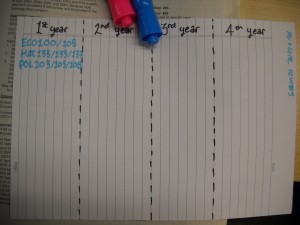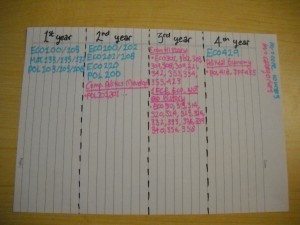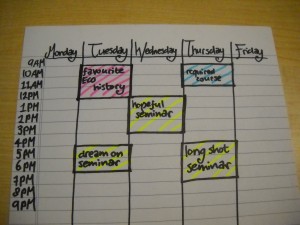Hey y’all, happy summer, happy post-Pride, happy heat wave!
It’s a beautiful morning here in Koffler, if a bit muggy outside, I’m visualizing the wonderful salad I’m going to eat at lunch today, and a few mornings ago I had the
Best.
ROSI experience.
Ever.
This is my fourth year enrolling in courses, so maybe I was due for a drama-free date with Lady ROSI (I used to picture this
ROSI). I certainly hoped so. I had a great start time this year thanks to my year and Joint Specialist, which is brutal because it has so many requirements, but great for priority (P*) because it has
so many requirements.
But I think beyond ROSI being
a glorious, powerful creature this year, maybe I’ve learned a few tricks of the trade over the years that made this time go so smoothly.
How smoothly? My start time was at 7:10am and I signed in right then. My best-case-scenario schedule involved one course which has only five spaces, and only two of those were left by my start time, one seminar with seven spots left, and two classes with about 50 spots. I signed in, signed up and got Every. Last. One. I looked up and the time was 7:11.
One minute, four courses, no conflicts, no crying, no crashing computers, no need to refresh page.
To be perfectly honest, my ROSI drama doesn’t compare with
others’, but I’ve had my fair share of freezing screens, waitlists, inability to enroll in more, and all-around insane stress. Except this year. Why? Well, since you ask, here they are, my tried, tested and true course selection tips. Warning: I bear a striking resemblance to
Zooey Deschanel’s character in
500 Days of Summer.
Once you have an idea
what program you want to be in, comb through its requirements. I find it helpful to write everything down in either flow-chart or mind-map form. I recommend having a rough list to begin with that’s basically just re-writing the program requirements in a way you can visually understand, whether that means writing out what the codes mean until they make sense (and don’t be afraid to call in re-enforcements!), or whatever. Biting off chunks at a time is less overwhelming, so I separate things into years to begin with and write down the core courses - classes that I have to take - for each year starting with my first.

Then, I go through my later years’ core courses, noting the pre-reqs for them, and adding those into the previous year’s required courses. Next, I look at other requirements, from most restrictive (least choices available) to least restrictive - in my case, I had to take a fourth year Political Economy course and there were only two options, so they got priority in terms of making sure either fit in, in contrast to, say, “a 300-level ECO course,” of which there are many available. So go through the specific requirement categories in terms of years, and make a subcategory under the year, like I’ve done, with the requirement and all the courses that can be counted towards it.

Then - the fun part! Or at least it’s fun for me (thankfully the cough*nerd*cough has gone out of style). You get to go through the options in the
calendar and see which ones sound interesting. I’m all about the colour coding, so I like to have colours for "most exciting," "medium exciting" and "oh please ROSI, no, no! I beg of you!"

I suggest doing this for each requirement category for each year, including the
degree requirements for, say, an Honours BA. If there’s a course that you are absolutely in love with, note its pre-reqs and slot them into their appropriate years. But WARNING! Courses get cancelled across years, something which jaded third years know all-too-well, although I certainly didn’t understand the magnitude of this as an eager first-year. I've waited with bated breath for certain classes only for them to be cruelly dropped from the listings without even a blank space and a red "cancel," as if I had dreamed them.
The silver lining is that often a fourth-year seminar that you think looks really cool in your first or second year has pre-reqs for a reason - they build your education in that direction. So looking at courses and pre-reqs can be a great way to get direction in the early going.
Though it’s different for everyone, at some point in this process I would *highly* recommend talking to your registrar or getting some kind of academic advice. Personally, I like to really sink my teeth into picking courses before I see my registrar, so I can build up a list of questions (which, likely, you will have - somehow codes are not always the clearest things in the world).
But be warned! The registrar’s office is the “it” spot on campus come start times, so try to get in early. Also, make sure you’re talking to the right person for your question - for questions about your degree requirements, your college or faculty is your spot, but for questions about your program there should be an advisor listed on the department’s site. Though they may not be this good across the board, the economics advisor is on it - a true ROSI wizard who answers questions precisely and effectively in record time. There are also a few online helpers kicking around, such as Degree Navigator (found right next to ROSI at the sign-in stage), which I have had some bad experiences with. To fill this void, U of T alum have been working with students to develop an online course selection tool,
project AUGUR, so stay tuned for it!
Okay, now that you have your completed year-by-year, you are ready to make your schedule! Though a lot of folks use Excel, I prefer the old-fashioned pen-to-paper method. Start with your core courses, find them in the timetable and slot them in. Then, play around a bit. See what times conflict with your core courses and make judgment calls: (1) Is either course necessary for that year as a pre-req for a subsequent year? (2) If both courses are year-flexible, which would suit your schedule better? For example, if one comes right after another and is all the way across campus, it might be better to opt for something closer. As well, which is better-suited in terms of coursework? I like having a mix of reading-heavy and problem-set heavy courses each year, but others find it better to focus on one type of work a year.
Finally, if there’s lots of flexibility across courses and times (you lucky devil!), there are basically two main factors: schedule and course content. Re: schedule, I like having morning classes so I get on campus early and can spend my days at the library, but friends of mine function better in the afternoon - it’s totally personal and totally a learning process of what works for you.
For course content, use the calendar as your starting point, but beyond that there are lots of resources at your disposal. ASSU releases the anti-calendar every year which is worth its weight in GPA points. It describes classes in terms of workload and difficulty and ranks the profs in a number of areas, all based on evaluations students who took the course last year filled out. I pay special attention to the retake rate, as well as the proportion of the class who responded - the higher the proportion, the more reliable the results, I’ve found.

Once you’ve made your dream schedule, make a few back-ups based on if-then scenarios. For example, if I don’t get into this course which has “x” spots available, then my schedule will look like this; if I don’t get into this other course, my schedule will look like this. Also, it’s good to have a list on hand of classes that fill certain requirements, listed from most desirable to least so if you don’t get into one, you can just move on to the next one. (Note: as course selection approaches, you can check how many spots are left by clicking on “course enrolment” in the sidebar, then “view timetable/spaces” and entering the course code in question - with that and your start time, you can get a pretty accurate idea of how likely it is that you’ll be able to get in.)
Phew! Okay, I think that’s it! I’ve either just helped a few people, or exposed to everyone that I am absolutely insane. But if you have any questions post them in the comments. This year I fielded questions from friends for a few weeks prior, figured out what one friend needed to graduate the night before, and actually enrolled a friend who was stuck in traffic the day of, so it’s safe to say I know my way around the process a little too well. Also, the skills are totally non-transferable, so I have to put them to use while I can.
Happy heatwave, y’all! And I hope you're schedules end up like this..

- Liz
 Then, I go through my later years’ core courses, noting the pre-reqs for them, and adding those into the previous year’s required courses. Next, I look at other requirements, from most restrictive (least choices available) to least restrictive - in my case, I had to take a fourth year Political Economy course and there were only two options, so they got priority in terms of making sure either fit in, in contrast to, say, “a 300-level ECO course,” of which there are many available. So go through the specific requirement categories in terms of years, and make a subcategory under the year, like I’ve done, with the requirement and all the courses that can be counted towards it.
Then, I go through my later years’ core courses, noting the pre-reqs for them, and adding those into the previous year’s required courses. Next, I look at other requirements, from most restrictive (least choices available) to least restrictive - in my case, I had to take a fourth year Political Economy course and there were only two options, so they got priority in terms of making sure either fit in, in contrast to, say, “a 300-level ECO course,” of which there are many available. So go through the specific requirement categories in terms of years, and make a subcategory under the year, like I’ve done, with the requirement and all the courses that can be counted towards it.
 Then - the fun part! Or at least it’s fun for me (thankfully the cough*nerd*cough has gone out of style). You get to go through the options in the calendar and see which ones sound interesting. I’m all about the colour coding, so I like to have colours for "most exciting," "medium exciting" and "oh please ROSI, no, no! I beg of you!"
Then - the fun part! Or at least it’s fun for me (thankfully the cough*nerd*cough has gone out of style). You get to go through the options in the calendar and see which ones sound interesting. I’m all about the colour coding, so I like to have colours for "most exciting," "medium exciting" and "oh please ROSI, no, no! I beg of you!"
 I suggest doing this for each requirement category for each year, including the degree requirements for, say, an Honours BA. If there’s a course that you are absolutely in love with, note its pre-reqs and slot them into their appropriate years. But WARNING! Courses get cancelled across years, something which jaded third years know all-too-well, although I certainly didn’t understand the magnitude of this as an eager first-year. I've waited with bated breath for certain classes only for them to be cruelly dropped from the listings without even a blank space and a red "cancel," as if I had dreamed them.
The silver lining is that often a fourth-year seminar that you think looks really cool in your first or second year has pre-reqs for a reason - they build your education in that direction. So looking at courses and pre-reqs can be a great way to get direction in the early going.
Though it’s different for everyone, at some point in this process I would *highly* recommend talking to your registrar or getting some kind of academic advice. Personally, I like to really sink my teeth into picking courses before I see my registrar, so I can build up a list of questions (which, likely, you will have - somehow codes are not always the clearest things in the world).
But be warned! The registrar’s office is the “it” spot on campus come start times, so try to get in early. Also, make sure you’re talking to the right person for your question - for questions about your degree requirements, your college or faculty is your spot, but for questions about your program there should be an advisor listed on the department’s site. Though they may not be this good across the board, the economics advisor is on it - a true ROSI wizard who answers questions precisely and effectively in record time. There are also a few online helpers kicking around, such as Degree Navigator (found right next to ROSI at the sign-in stage), which I have had some bad experiences with. To fill this void, U of T alum have been working with students to develop an online course selection tool, project AUGUR, so stay tuned for it!
Okay, now that you have your completed year-by-year, you are ready to make your schedule! Though a lot of folks use Excel, I prefer the old-fashioned pen-to-paper method. Start with your core courses, find them in the timetable and slot them in. Then, play around a bit. See what times conflict with your core courses and make judgment calls: (1) Is either course necessary for that year as a pre-req for a subsequent year? (2) If both courses are year-flexible, which would suit your schedule better? For example, if one comes right after another and is all the way across campus, it might be better to opt for something closer. As well, which is better-suited in terms of coursework? I like having a mix of reading-heavy and problem-set heavy courses each year, but others find it better to focus on one type of work a year.
Finally, if there’s lots of flexibility across courses and times (you lucky devil!), there are basically two main factors: schedule and course content. Re: schedule, I like having morning classes so I get on campus early and can spend my days at the library, but friends of mine function better in the afternoon - it’s totally personal and totally a learning process of what works for you.
For course content, use the calendar as your starting point, but beyond that there are lots of resources at your disposal. ASSU releases the anti-calendar every year which is worth its weight in GPA points. It describes classes in terms of workload and difficulty and ranks the profs in a number of areas, all based on evaluations students who took the course last year filled out. I pay special attention to the retake rate, as well as the proportion of the class who responded - the higher the proportion, the more reliable the results, I’ve found.
I suggest doing this for each requirement category for each year, including the degree requirements for, say, an Honours BA. If there’s a course that you are absolutely in love with, note its pre-reqs and slot them into their appropriate years. But WARNING! Courses get cancelled across years, something which jaded third years know all-too-well, although I certainly didn’t understand the magnitude of this as an eager first-year. I've waited with bated breath for certain classes only for them to be cruelly dropped from the listings without even a blank space and a red "cancel," as if I had dreamed them.
The silver lining is that often a fourth-year seminar that you think looks really cool in your first or second year has pre-reqs for a reason - they build your education in that direction. So looking at courses and pre-reqs can be a great way to get direction in the early going.
Though it’s different for everyone, at some point in this process I would *highly* recommend talking to your registrar or getting some kind of academic advice. Personally, I like to really sink my teeth into picking courses before I see my registrar, so I can build up a list of questions (which, likely, you will have - somehow codes are not always the clearest things in the world).
But be warned! The registrar’s office is the “it” spot on campus come start times, so try to get in early. Also, make sure you’re talking to the right person for your question - for questions about your degree requirements, your college or faculty is your spot, but for questions about your program there should be an advisor listed on the department’s site. Though they may not be this good across the board, the economics advisor is on it - a true ROSI wizard who answers questions precisely and effectively in record time. There are also a few online helpers kicking around, such as Degree Navigator (found right next to ROSI at the sign-in stage), which I have had some bad experiences with. To fill this void, U of T alum have been working with students to develop an online course selection tool, project AUGUR, so stay tuned for it!
Okay, now that you have your completed year-by-year, you are ready to make your schedule! Though a lot of folks use Excel, I prefer the old-fashioned pen-to-paper method. Start with your core courses, find them in the timetable and slot them in. Then, play around a bit. See what times conflict with your core courses and make judgment calls: (1) Is either course necessary for that year as a pre-req for a subsequent year? (2) If both courses are year-flexible, which would suit your schedule better? For example, if one comes right after another and is all the way across campus, it might be better to opt for something closer. As well, which is better-suited in terms of coursework? I like having a mix of reading-heavy and problem-set heavy courses each year, but others find it better to focus on one type of work a year.
Finally, if there’s lots of flexibility across courses and times (you lucky devil!), there are basically two main factors: schedule and course content. Re: schedule, I like having morning classes so I get on campus early and can spend my days at the library, but friends of mine function better in the afternoon - it’s totally personal and totally a learning process of what works for you.
For course content, use the calendar as your starting point, but beyond that there are lots of resources at your disposal. ASSU releases the anti-calendar every year which is worth its weight in GPA points. It describes classes in terms of workload and difficulty and ranks the profs in a number of areas, all based on evaluations students who took the course last year filled out. I pay special attention to the retake rate, as well as the proportion of the class who responded - the higher the proportion, the more reliable the results, I’ve found.
 Once you’ve made your dream schedule, make a few back-ups based on if-then scenarios. For example, if I don’t get into this course which has “x” spots available, then my schedule will look like this; if I don’t get into this other course, my schedule will look like this. Also, it’s good to have a list on hand of classes that fill certain requirements, listed from most desirable to least so if you don’t get into one, you can just move on to the next one. (Note: as course selection approaches, you can check how many spots are left by clicking on “course enrolment” in the sidebar, then “view timetable/spaces” and entering the course code in question - with that and your start time, you can get a pretty accurate idea of how likely it is that you’ll be able to get in.)
Phew! Okay, I think that’s it! I’ve either just helped a few people, or exposed to everyone that I am absolutely insane. But if you have any questions post them in the comments. This year I fielded questions from friends for a few weeks prior, figured out what one friend needed to graduate the night before, and actually enrolled a friend who was stuck in traffic the day of, so it’s safe to say I know my way around the process a little too well. Also, the skills are totally non-transferable, so I have to put them to use while I can.
Happy heatwave, y’all! And I hope you're schedules end up like this..
Once you’ve made your dream schedule, make a few back-ups based on if-then scenarios. For example, if I don’t get into this course which has “x” spots available, then my schedule will look like this; if I don’t get into this other course, my schedule will look like this. Also, it’s good to have a list on hand of classes that fill certain requirements, listed from most desirable to least so if you don’t get into one, you can just move on to the next one. (Note: as course selection approaches, you can check how many spots are left by clicking on “course enrolment” in the sidebar, then “view timetable/spaces” and entering the course code in question - with that and your start time, you can get a pretty accurate idea of how likely it is that you’ll be able to get in.)
Phew! Okay, I think that’s it! I’ve either just helped a few people, or exposed to everyone that I am absolutely insane. But if you have any questions post them in the comments. This year I fielded questions from friends for a few weeks prior, figured out what one friend needed to graduate the night before, and actually enrolled a friend who was stuck in traffic the day of, so it’s safe to say I know my way around the process a little too well. Also, the skills are totally non-transferable, so I have to put them to use while I can.
Happy heatwave, y’all! And I hope you're schedules end up like this..
 - Liz
- Liz
Hello I stumbled upon this post while looking at this site and found this extremely useful! I’m actually considering attending U of T this fall. Are your weekly timetables usually like this throughout your 4 years?? How many credits are you taking every year? I’m actually thinking of taking 6 credits for one full-year – will my classes exceed 6 hours every day?